VOL. 40, #4, Winter 2022
How We Avoided a 6 Figure Colombian Emerald Disaster, Collecting Gems, Heists and Robberies, Auction News
- Home
- Newsletter
- VOL. 40, #4, Winter 2022
How We Avoided a 6 Figure Colombian Emerald Disaster, Collecting Gems, Heists and Robberies, Auction News
How We Avoided a 6 Figure Colombian Emerald Disaster
By Robert G. Genis
This is a true story about a gem deal gone bad. A client of mine was interested in buying an untreated Colombian emerald. Although out of the country and not able to personally inspect the rock, I found this 5.64 AGL graded emerald for my client.
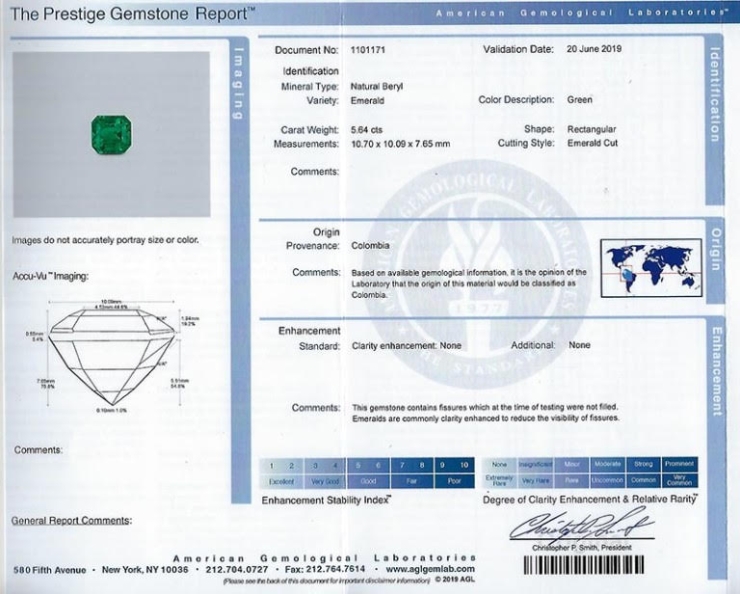
I have known the owner/dealer of the stone for decades and never had a problem. We requested a brand new AGL even though it was graded just a few years ago. As many of you know, I'm fine with old AGL documents owned by my collectors, especially for Burma ruby, Burma sapphire and Burma spinel. First, the new AGL reports have dropped the color scan, which is a vital component for many collectors. Also, there is no financial incentive to treat untreated gems, because they would do nothing but lose value. Further, most of my collectors do not possess the technical expertise nor the interest to even attempt to mess with their stones. They stay safe and sound in safety deposit boxes or in underground vaults.
Back to the story. As many of you know, this is a 6 figure gemstone IF, as advertised, it is not clarity enhanced. The stone was shipped to AGL for an updated document. The gem came back as clarity enhanced!
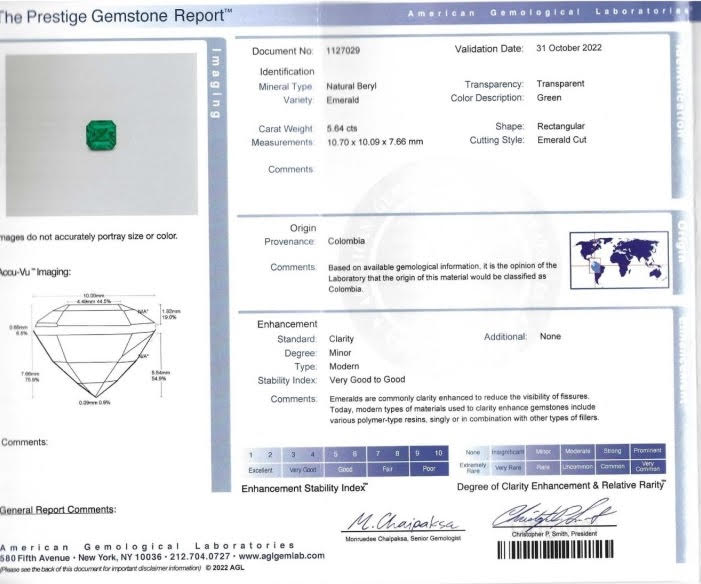
Of course, the deal was off and my client was saved from buying a treated emerald. The owner/dealer surely didn't know the stone was treated by someone between 2019 and 2022. If he had personally treated the stone, he never would have agreed to send the stone to AGL. Remember, if a dealer refuses to submit anything to AGL, run, don't walk away from the deal. Here you can see the difference of the stone treated vs. not treated.
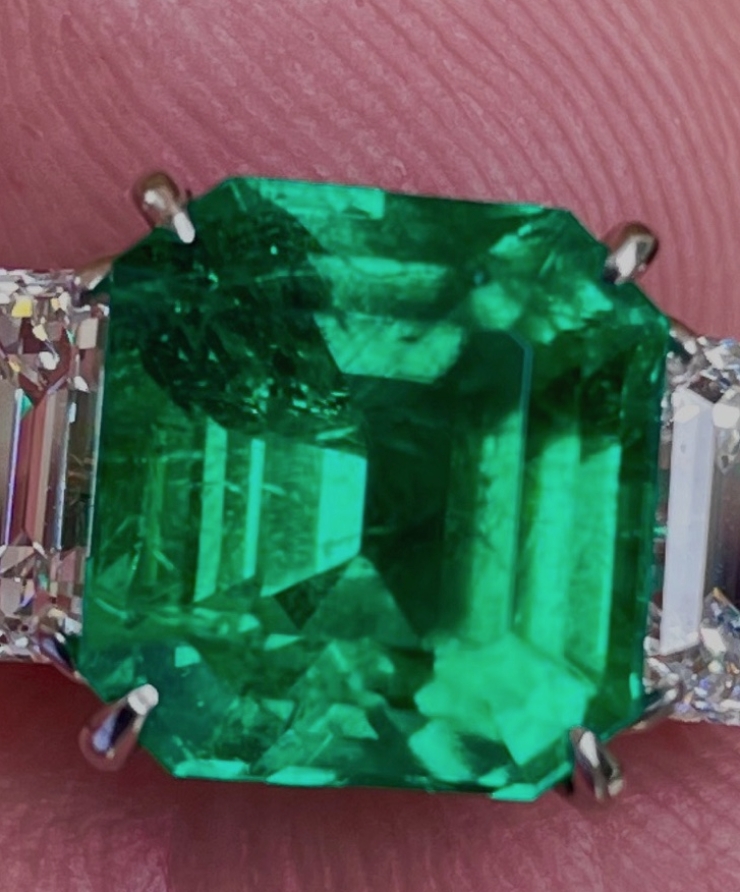 |
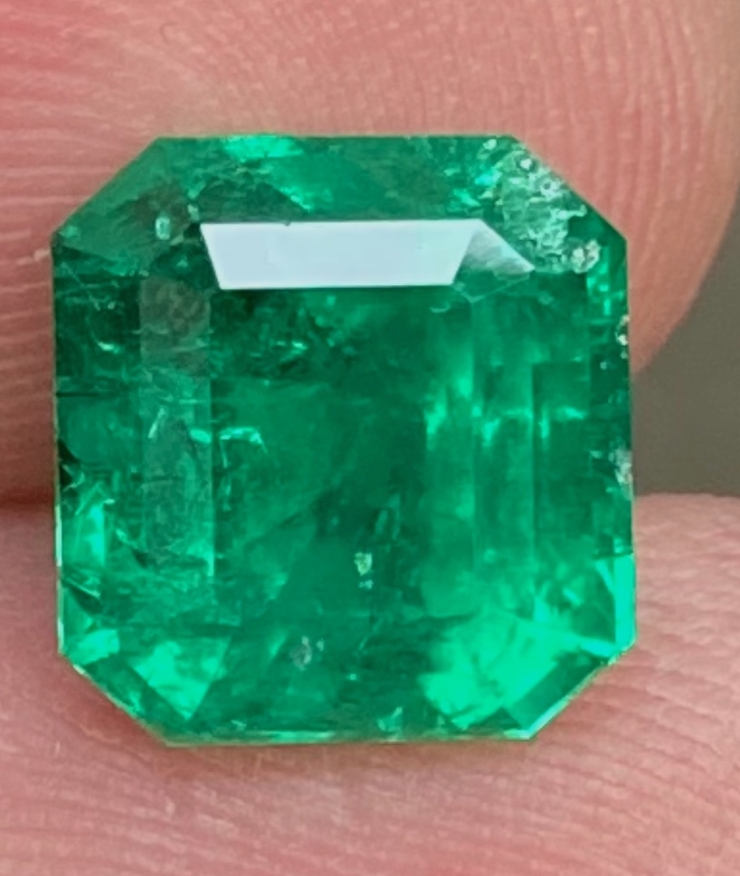 |
| 5.64 Colombian emerald, clarity enhanced | 5.64 Colombian emerald, not clarity enhanced (post removal of filler) |
The treated stone is on the left. That is what we thought the stone looked like, supposedly untreated. After AGL called the stone treated, a professional service gave the stone an acetone bath to remove the filler. The right picture shows what the same stone really looks like untreated. Quite a difference. The owner/dealer lost a great deal of money on this rock, as now it's worth fraction of the original asking price.
So what happened between 2019 and 2022? It isn't clear, but obviously, someone treated this emerald. Was it another dealer or a retail jeweler? We may never know the truth. Just glad we asked for new paper. Let this be a lesson for anyone buying untreated Colombian emeralds. They are easy to treat, and it makes a big difference in their appearance and their value. Make sure you get AGL confirmation that no one has messed with the stone you want to buy. Probably not important if the stone is already treated, but if untreated it is a MUST. With non clarity enhanced Colombian emeralds, it's better to be safe than sorry. Especially since 99% of all emeralds are clarity enhanced. Caveat emptor.
Collecting Gems
Investing in gemstones? How to make the right choice. Precious stones are a good option for those looking to diversify their investment portfolios
New Delhi
by Umang Gupta
Sep 19, 2022
An interesting article written by an Indian jeweler. Although jewelers have different perspectives than collector/investor houses, the article makes some excellent points. However, we disagree with his lab choices and prefer AGL over anyone else, even the GIA, except of course for diamonds. ED
With Queen Elizabeth II’s passing, the famous Kohinoor diamond has resurfaced to become a topic of discussion on dinner tables and in the Twitter-sphere. Weighing 105.6 carats, this uncut diamond now sits on the crown of King Charles III. Currently valued at an estimated $400 million, one can only wonder what the trajectory of that diamond would be if one invested in it under different circumstances. If the diamond piece was open to the general public for investment, would it be wise to invest in it? If we look into the history of investments, traditionally one would put their money in gold, shares, bonds, property and mutual funds. One may even consider the new age NFTs or bitcoins if that tickles their fancy. But if you’re looking to diversify your portfolio with something that has long-term benefits, then you should consider precious stones as an option.
Here are a few things to consider before you start:
Size Doesn't Matter
It’s understood in the jewelry industry that rare precious stones are the most sought after. But in terms of investing, a low to medium-sized gem demands a lower price and has a higher chance of appreciating. It will also be easier to liquidate.
The Right Gem
It’s important to keep an eye on the jewelry trends and choose the right kind of gem for your investment. It’s always a safe bet to pick rare vintage pieces, but if you get your hands on Burmese rubies, Kashmir sapphires, Colombian emeralds or any colored diamonds, don’t even pause to think twice before investing.
Take It To The Bank
You need to secure your investment in stones. Try not to store them at home, but keep them safely in a bank or locker where the chance of damage is low. Remember, water and overexposure to air and humidity can really damage your jewelry.
Deal With The Best
The most important factor when investing is to find and buy from the right source. There are many jewelers who would like to pass off sub-par-quality gems as something else. Always ask for and check the certificates. The best ones in the industry are GIA or IGI authenticated certificates. It is also important to do your homework before investing. Check if the piece has the potential to appreciate, is it a cut stone, and what is the possible markup you would probably get after investing. Much like you would speak to a doctor for a second opinion, when investing in gems, it always helps to ask another certified gemologist for their opinion. They will help you identify potential pros and pitfalls of the gemstone you are interested in.
Make Money By Adding Value
You can add value to your investment in many ways. One easy way would be to invest in gemstones and turn your low-value investment into a high-value one. This can be achieved by, for instance, selling your gems as a collective piece by asking a jeweler to use the gemstones to make a beautiful jeweled accessory that can be sold.
A Safe Bet
It’s safe to say that when the stock market is in turmoil and currency is losing its value, jewelry doesn’t fail during a recession. What may happen is that one might have fewer buyers for the gems. However, the value of the gem doesn’t deteriorate, making it safe from economic fluctuations.
Know Your Gems: Sapphire vs. Ruby vs. Emerald
Babyboomers.com
by Staff
Dec 12 2022
This blog has some good information but many errors. We have fixed the most obvious mistakes by adding comments and cut other sections for space. ED
Diamonds are known to be a girl’s best friend. No doubt. But if you want your jewelry to have more color and sparkle, you might also want to buy some beautiful gemstones. Speaking of which, emerald, sapphire, and ruby are the "big three" gems that are becoming more and more popular and as valuable as diamonds.
At the moment, emerald, sapphire, and ruby are the only stones that are considered precious. (Don't forget Paraiba tourmaline. ED) The rest of the gems are considered "semi-precious." "Precious stones" have a "high value," which means that they cost more per carat than a diamond. Gemstones are valuable for a number of reasons. These include how rare, popular, long-lasting, and, of course, beautiful something is.
Sapphire: Among the many varieties of the mineral corundum, sapphire stands out. There are traces of aluminum oxide and other elements like iron, titanium, chromium, vanadium, and magnesium.
The aluminum oxide in a sapphire's crystal structure contains trace components responsible for the gemstone's distinctive hue. Sapphires are most commonly blue. However, their color can vary based on the number of elements they contain.
Ruby: A ruby is just a red variety of the same material that makes up a sapphire. The name "ruby" is given to the red variety of the mineral corundum. The only other corundum hue not designated a sapphire is this one.
Therefore, a ruby is merely a red sapphire (or red corundum). Chrome gives rubies and purple sapphires their distinctive hues. However, red corundum has a deeper pinkish-to-blood-red color due to a higher concentration of chromium.
Emeralds: In the mineral kingdom, emeralds are classified as a subgroup of the beryl family. The chromium and vanadium in its composition are mostly responsible for its stunning hue. Emeralds, unlike sapphires, are invariably green. However, the shade and saturation of their color can change.
Sapphire: Natural sapphires have been around for a very long time. Over the course of more than 150 million years, they formed due to changes in heat and pressure deep inside the Earth's crust.
In addition, sapphires don't form in any old rock; rather, they crystallize in a specific type of igneous or metamorphic rock that is low in silicon and high in aluminum during a lengthy cooling process. Stones (granite, schist, gneiss, nepheline, and more) containing sapphires are sourced from Madagascar, Tanzania, Myanmar, Sri Lanka, and Montana deposits.
Ruby: Since rubies are also a type of corundum, the same rules apply to them. The only thing we can offer is that South East Asia (Cambodia, Thailand, Myanmar, Sri Lanka, and Afghanistan) (Don't forget Africa. ED) is home to the vast majority of the world's ruby supply.
Emeralds: Beryl, which creates emeralds, grows as hexagonal crystals in hydrothermal veins and magmatic pegmatites deep within the Earth. It needs the correct conditions (temperature and volume) and the presence of the elements beryllium, aluminum, silicon, and oxygen. But that is specific to beryl.
Emeralds are only found in beryl, which is a vivid green color. In its purest form, beryl has no discernible hue. Beryl can only turn green if its soil contains traces of chromium and vanadium.
Similar to sapphires, this process takes a very long time to complete. Similar to sapphires, emeralds can be mined in locations all over the world. However, significant exports originate in Colombia, Brazil, and Zambia
Sapphire: Sapphires come in various colors, with blue being the most common and well-known. They come in a broad spectrum of hues, from colorless to pink, orange, yellow, black, and purple. What we mean by "in-between" is that the overtone and hue of sapphire can vary from stone to stone based on the trace elements present.
The purest velvety blue (such as that of Kashmir blue sapphires) and the orange-pink hue are the most coveted and expensive. Everyone has their preferences, so any sapphire with a deep hue will be in demand and fetch a high price. For this reason, regardless of the exact hue, a sapphire's value increases as its color becomes more profound and more saturated.
Ruby: Even while red is the most common hue associated with rubies, their shade can range from orange to purple to pink to brown. To be considered a ruby, the dominant color must be red. The best-quality rubies will fall between the two extremes, with vivid red and somewhat purplish red being the preferred tones.
Emeralds: The predominant color of an emerald is always green, but they can also have secondary colors, like yellow or blue. In terms of tone, an emerald needs to be between medium and dark to be considered an emerald rather than a green beryl. In general, emeralds that range from a bluish green to pure yellowish green in hue, have a high degree of color saturation, and have a medium to not too-dark tone are the most highly sought.
Sapphire: It's important to know that nearly all natural sapphires have inclusions that aren't immediately obvious. It is likely a synthetic lab-created sapphire if a magnification loupe reveals no inclusions. Even an elegant-looking clear ruby comes high on the Mohs scale (scale of mineral hardness), around 9.
Generally, the rarer a sapphire is, the fewer inclusions it has. Type 1 has no noticeable inclusions, Type 2 and 3 have some slight inclusions, and Type 3 has large inclusions. Most people agree that Type 1 sapphires are the most desirable and expensive.
Ruby: While inclusions and faults are widespread in diamonds, they are also relatively common in rubies. Although inclusions are not the primary factor in determining the value of a ruby, especially when it is used in jewelry, it is nevertheless preferable to avoid those that are very large or obvious. These include chipping, cavity faults, feather flaws, and crystal inclusions.
Emeralds: Like sapphires and rubies, emeralds form tiny inclusions of gases, minerals, crystals, and liquids called "inclusions" during crystallization. Almost all emeralds will include inclusions that can be seen with the naked eye, making them a natural part of the stone.
Even though emeralds are graded on the same scale as sapphires (Type 1-Type 3), even the highest-quality Type 1 emeralds may have noticeable inclusions. If you're in the emerald or emerald jewelry market, you should steer clear of stones with heavy inclusions or overly visible flaws.
Please be aware that there are so many variables (color, clarity, carat weight, cut, and treatment) that it is nearly impossible to estimate general pricing for sapphires, rubies, or emeralds. However, ruby is generally the most expensive, followed by emerald and sapphire. It's not quite as near, but it's close enough, and all three are valuable if they're natural, high-quality, and untreated.
The gemstone market in the year 2020 is estimated to be over US$ 30,779.1 million, and all these gemstones have a major contribution to it. The three precious stones of sapphire, ruby, and emerald are stunning, rare, and highly valued, making it difficult to pick just one.
However, in the end, the choice of hue is entirely subjective. The three precious stones of sapphires, rubies, and emeralds are essential accessories for the well-to-do. We hope you find the data informative. Choose the one that calls you the most. Sapphires, rubies, and emeralds are always safe bets.
Heists and Robberies
Curious Tale of the "Spiritually Cleansed" Diamond
IDEX
by John Jeffay
December 15, 2022
This would make a great movie. You can't make this stuff up. ED
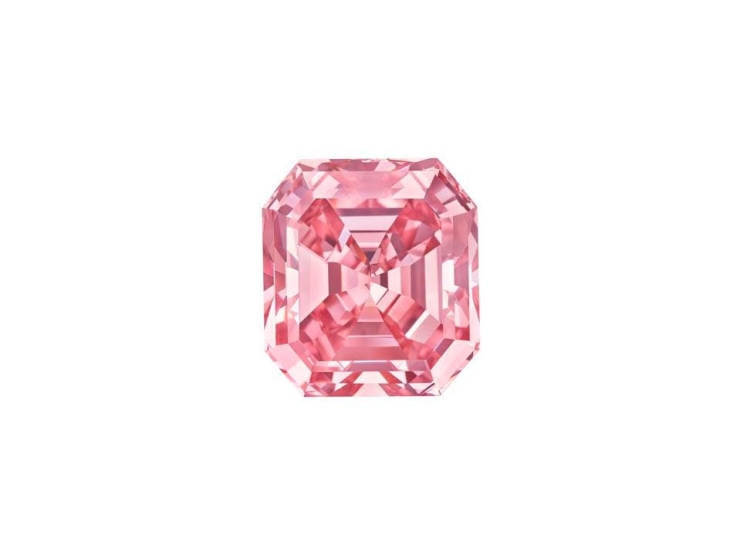 |
It's one thing when one of the world's most valuable diamonds is mysteriously pulled from auction. It's quite another when it turns out the reason is an allegation that the 13.15-carat fancy vivid pink gem had been sent from Qatar to the USA, to be "spiritually cleansed" by an online psychic. They do say that fact is stranger than fiction.
This is how it unfolded. Last month Christie's New York announced that on 6 December it would be selling a "magnificently rare" diamond, with impressive saturation, step-cut facets and a clarity grade of potentially Internally Flawless." It carried an estimate of $25m to $35m.
Less than two weeks before the sale the gem, described as having come from a "private collector", was withdrawn, without explanation. The reason for withdrawal only became clear thanks to the vigilance of Court Watch, an online group that monitors federal court filings.
They say the criminal complaint (filed on 21 November) sat "untouched and unreported for three weeks because no one reads past the first few pages of mail fraud charges". But they read past the dreary, legal preamble to Case No 8:22-mj-2127-SPF, United States of America v. John Lee, and stumbled upon a gem of a story.
It's important, of course, to say that charges against defendant John Lee of wire fraud, mail fraud and interstate transportation of stolen goods have not been proven. The following version of events is taken directly from an affidavit sworn by a Homeland Security special agent in support of the criminal complaint.
Lee, from Davenport, Florida, advertised himself as psychic coach on the Purple Garden website, charging by the minute for advice on love and relationships. The FBI became aware that he was in correspondence with a person identified only as "Victim 1", from Doha, Qatar, who was seeking help for "negative feelings".
In June of this year he directed them to send items of their own jewelry to be "spiritually cleansed" of bad spirits. He then persuaded them to remove jewelry from their employer's safe and FedEx it to him. He said he'd return them in a face-to-face meeting in Cannes, France, but didn't show up.
A package sent from Doha and addressed to Lee, contained a white diamond weighing around 42-carats and two large canary diamonds (weights not disclosed). A second package, sent in July, contained a canary diamond of approximately 12 carats. A third contained a necklace of about 150 diamonds and a fourth contained what is described as "an approximately 20-carat pink diamond".
The owner later provided details of at least 17 items of diamond, ruby, and sapphire jewelry, as well as watches, with a total purchase price of over $90m.
A diamond matching the description of the stolen pink gem was offered to a jewelry business in New York in mid-August. A jeweler identified only as "Witness 1" made the link between the diamond and its rightful owner, who confirmed it was missing.
On 14 November, Christie's New York proudly announced the sale of "a superb fancy vivid pink emerald-cut diamond, one of the largest ever offered at auction at 13.15 carats".
On or around that date, agents learned that "the pink diamond was slated to be auctioned by Auction House 1 ("AH-1"), located in New York, New York, in December 2022.
"Agents, who were in the vicinity during the showing of the pink diamond, took immediate possession of the stone as it was readily apparent the diamond was stolen property."
The affidavit says that Lee traded the pink diamond, valued at $31m, for watches and loose diamonds worth $8m.
We asked Christie's to comment. "We can confirm that we cooperated with the authorities," a spokesperson said, "but Christie's does not comment on ongoing investigations to which we are not a party".
Auction News
Auction News
Ring With Emerald Recovered From 400-Year-Old Shipwreck Raises $1.2 Million For Ukraine At Auction
Forbes
by Carlie Porterfield
Dec 8, 2022
Naturally, this is a special humanitarian case with an interesting provenance and doesn't increase the value of all emeralds. ED
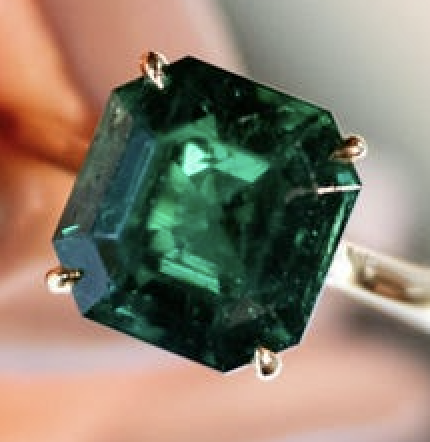 Source: Sotheby's |
A ring set with an emerald that was rediscovered on a Spanish shipwreck nearly 400 years after being lost sold for $1.2 million at auction, with all proceeds set to be donated to humanitarian efforts in Ukraine.
Key Facts
Big Number
$1.1 billion. That’s how much the Atocha’s treasure was estimated to be worth in 1985 ($400 million) adjusted for inflation today.
Key Background
The Atocha, built in Cuba in the 1600s, had been commissioned by a Spanish government agency that regulated colonization efforts to transport goods, and when it sank it had been loaded up with the belongings of noble passengers returning to Spain from Latin America. When Fisher announced he found the wreck, it was among the most successful treasure hunts in history, and Florida wanted a cut. The state said it had a claim on the wreck and had Fisher sign a contract that designated the state would take 25% of the treasure. After years of court battles, the Supreme Court ruled in 1982 that Florida did not have a stake in the treasure and declared the finders the full owners. The hoard was split up among the team and investors. Fisher died in 1998.